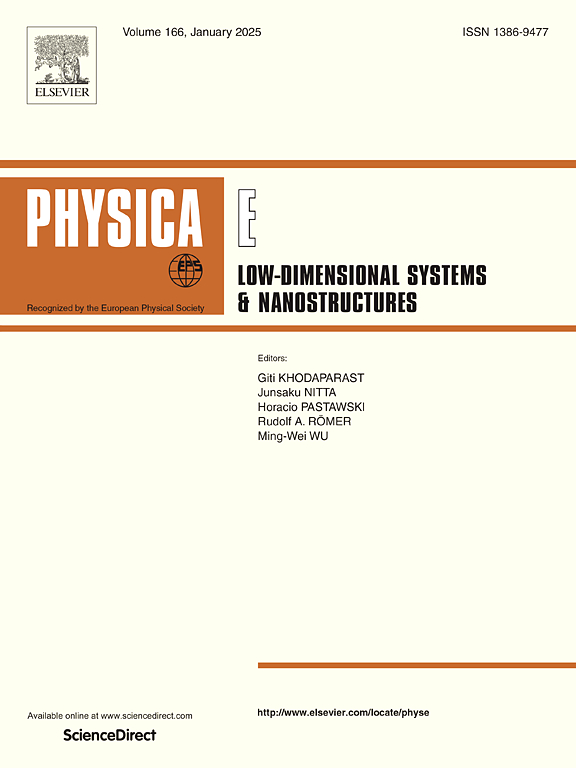Quantitative analysis of lithium compounds on the electrode surface and electrical conductivity with pure CNT effects for Li-ion capacitor application
IF 2.9
3区 物理与天体物理
Q3 NANOSCIENCE & NANOTECHNOLOGY
Physica E-low-dimensional Systems & Nanostructures
Pub Date : 2025-07-23
DOI:10.1016/j.physe.2025.116337
引用次数: 0
Abstract
In the case of lithium-ion capacitors (LIC), power density or rate performance is greatly limited by conductive materials due to differences in ion and electron conduction mechanisms. Due to the surface modification, different functional groups are generated, which is confirmed that these lithium salts were formed by the reaction of lithium with the functional group present on the surface of the electrode material. The functional group of lithium compound was confirmed from the chemical analysis results, and possible structures were proposed for them through simulation. In addition, the correlation between the amounts of lithium compounds formed on the electrode and electrical conductivity was studied using four types of electrodes according to the content of CNT. We analyzed using powdered X-ray diffraction (XRD), Raman spectroscopy, XPS, FTIR, SEM, TEM, Cyclic voltammetry (CV), and various electrochemical experiments. According to the YPCNT 15 results, it has good adsorption pore width that strongly impacts the effectiveness of adsorption and kinetics. Increased amount of MWCNTs (YPCNT 15) to extensively impact on the current density range 0.45 (ma/cm2) and excellent rate of performance with the density of 29 (Wh/g) and capacitance 0.45 (F/g) that enhance as the insertion and deinsertion of Li-ions. Furthermore, it was proved that the characteristics are improved through evaluation of their characteristics. From the results of comparing the electrochemical properties of the manufactured half-cell, YPCNT15 showed improved results in all the measured result values depending on the content of the added CNT.
定量分析锂化合物在电极表面和电导率与纯碳纳米管效应的锂离子电容器应用
在锂离子电容器(LIC)的情况下,由于离子和电子传导机制的差异,导电材料极大地限制了功率密度或速率性能。由于表面修饰,生成了不同的官能团,证实了这些锂盐是锂与电极材料表面存在的官能团反应形成的。从化学分析结果确定了锂化合物的官能团,并通过模拟提出了可能的结构。此外,根据碳纳米管的含量,采用四种类型的电极,研究了电极上形成的锂化合物的量与电导率的相关性。采用粉末x射线衍射(XRD)、拉曼光谱(Raman)、XPS、FTIR、SEM、TEM、循环伏安法(CV)和各种电化学实验进行分析。根据YPCNT 15的结果,它具有良好的吸附孔径,这对吸附效果和动力学有很大影响。MWCNTs (YPCNT 15)用量的增加对电流密度范围0.45 (ma/cm2)和性能的优异率产生了广泛的影响,其密度为29 (Wh/g),电容为0.45 (F/g),随着锂离子的插入和移除而增强。通过对其特性的评价,证明了其特性得到了改善。通过对制备的半电池的电化学性能进行比较,发现随着碳纳米管的添加量的增加,YPCNT15的所有测量结果值都有所改善。
本文章由计算机程序翻译,如有差异,请以英文原文为准。
求助全文
约1分钟内获得全文
求助全文
来源期刊
CiteScore
7.30
自引率
6.10%
发文量
356
审稿时长
65 days
期刊介绍:
Physica E: Low-dimensional systems and nanostructures contains papers and invited review articles on the fundamental and applied aspects of physics in low-dimensional electron systems, in semiconductor heterostructures, oxide interfaces, quantum wells and superlattices, quantum wires and dots, novel quantum states of matter such as topological insulators, and Weyl semimetals.
Both theoretical and experimental contributions are invited. Topics suitable for publication in this journal include spin related phenomena, optical and transport properties, many-body effects, integer and fractional quantum Hall effects, quantum spin Hall effect, single electron effects and devices, Majorana fermions, and other novel phenomena.
Keywords:
• topological insulators/superconductors, majorana fermions, Wyel semimetals;
• quantum and neuromorphic computing/quantum information physics and devices based on low dimensional systems;
• layered superconductivity, low dimensional systems with superconducting proximity effect;
• 2D materials such as transition metal dichalcogenides;
• oxide heterostructures including ZnO, SrTiO3 etc;
• carbon nanostructures (graphene, carbon nanotubes, diamond NV center, etc.)
• quantum wells and superlattices;
• quantum Hall effect, quantum spin Hall effect, quantum anomalous Hall effect;
• optical- and phonons-related phenomena;
• magnetic-semiconductor structures;
• charge/spin-, magnon-, skyrmion-, Cooper pair- and majorana fermion- transport and tunneling;
• ultra-fast nonlinear optical phenomena;
• novel devices and applications (such as high performance sensor, solar cell, etc);
• novel growth and fabrication techniques for nanostructures

 求助内容:
求助内容: 应助结果提醒方式:
应助结果提醒方式:


